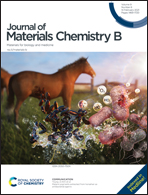Substrate stiffness and sequence dependent bioactive peptide hydrogels influence the chondrogenic differentiation of human mesenchymal stem cells†
Abstract
N-Cadherin is a transmembrane glycoprotein that plays a crucial role in the condensation of mesenchymal cells by enhancing cell–cell interactions during the process of chondrogenesis. The biophysical and biochemical signals can incite enhanced cell–cell contact which ultimately determines the fate of stem cells. The role of cadherin mimetic peptides on the differentiation of mesenchymal stem cells is obscure and must be explored in greater detail. In this study, we designed and synthesized a series of bioactive peptide sequences that mimic the EC-1 domain of the cadherin peptide sequence His-Ala-Val (HAV) motif. These peptide hydrogelators can self-assemble into stable supramolecular nanofibrous hydrogels at physiological pH in the presence of Fmoc-diphenylalanine (2) with tunable mechanical stiffness. Human mesenchymal stem cells (3A6) were encapsulated in N-cadherin mimetic peptide hydrogels to evaluate their role in stem cell differentiation and chondrogenesis. The results suggested that these peptide hydrogels are nontoxic to 3A6 cells and promoted chondrogenesis. Interestingly, 3A6 cells exposed to Fmoc-GGHAVDI (1d) peptide solution showed an enhanced expression level of chondrogenic specific marker collagen-II (Col-II) in comparison with other peptide sequences. In contrast, when 3A6 cells were encapsulated in the hydrogel blend (2/1c), the peptide sequence with flanking amino acid serine exhibited greater material stiffness with enhanced glycosaminoglycan (GAG) distribution and high expression levels of chondrogenic specific markers for the cartilage-specific matrix. This suggests that substrate stiffness and peptide sequences can influence stem cell differentiation. The hydrogel with the HAV motif with greater substrate stiffness (2/1c) can promote the chondrogenic differentiation of human mesenchymal stem cells which can be a promising candidate for 3D cell culture and stem cell-based cartilage regeneration therapies.

- This article is part of the themed collection: Journal of Materials Chemistry B Lunar New Year collection 2022


 Please wait while we load your content...
Please wait while we load your content...